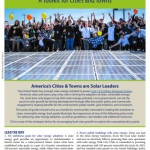
Trouble in Toyland 2012
27th Annual CALPIRG Toy Safety Survey
Survey Finds Dangerous Toys on Store Shelves. CALPIRG Provides Shopping Tips & Mobile Website To Help Parents Shop Safe.
Downloads
CALPIRG Education Fund

The 2012 Trouble in Toyland report is the 27th annual U.S. Public Interest Research Group (PIRG) survey of toy safety. In this report, U.S. PIRG provides safety guidelines for consumers when purchasing toys for small children and provides examples of toys currently on store shelves that may pose potential safety hazards.
Over the past twenty-seven years, the U.S. PIRG report has identified hazards in toys and children’s products that could cause acute injuries, from small parts that pose a choking hazard, to strangulation hazards from cords on pull toys, to laceration hazards from edges that are too sharp, to toxic hazards posed by chemicals in toys. Our report has led to at least 150 recalls and other regulatory actions over the years, and has helped us educate the public and policymakers on the need for stronger public health and consumer safety standards and for stronger federal laws to protect children from unsafe products. This report continues to be an important endeavor in keeping children – particularly babies and toddlers – safe, as the majority of all injuries happen to children in the 0-2 age range.[i]
The enactment of the Consumer Product Safety Improvement Act (CPSIA) of 2008 made great strides in toy safety and strengthened the ability of the Consumer Product Safety Commission (CPSC) to protect consumers, including the littlest consumers—children. Although policymakers delayed implementation of its most stringent lead standard rules and enacted some narrow exceptions in 2011, on the whole the law has been protected from attempts to undermine it. However, we remain vigilant as a variety of regulatory threats to the CPSC’s tools and authority remain under consideration by policymakers.[ii]
We Looked For Common Hazards in Toys
We visited numerous national toy stores, malls and dollar stores in September, October, and November 2012 to identify potentially dangerous toys. Our researchers examined the CPSC notices of recalls and other regulatory actions to identify trends in toy safety. Our investigation is focused on toys that posed a potential toxic, choking, strangulation or noise hazard.
Our Key Findings Include:
Lead Continues to be a Hazard in Toys
Exposure to lead can affect almost every organ and system in the human body, especially the central nervous system. Lead is especially toxic to the brains of young children and can cause permanent mental and developmental impairments; it has no business being in children’s products.
The current federal legal lead standard is 100 parts per million (ppm), though the American Academy of Pediatrics recommends a lead limit of 40 ppm. We found one toy that violates the CPSC’s lead standard of 100 ppm.
Phthalates in Toys
Numerous studies have documented the potential health effects of exposure to phthalates in the womb or in child development. U.S. EPA studies show the cumulative impact of different phthalates leads to an exponential increase in harm including premature delivery and reproductive defects.
The CPSIA permanently banned three phthalates from use in toys, and set temporary limits on three others, while tests continue. No toy or child care article can contain more than 1000 ppm of each of the six phthalates. Washington State has a stronger disclosure law than the federal standard, requiring the disclosure of any detectable level of phthalates.
Magnets in Toys
This year we are highlighting the continued dangers that magnet toys, such as the Buckyball magnets that are the subject of a CPSC court action, pose to children. These magnet toys are made with neodymium iron boron magnets. The magnets are extremely strong and can severely pinch fingers; worse, they can cause severe internal damage if swallowed. CPSC staff have estimated that between 2009 and 2011 there were 1,700 emergency room cases nationwide involving the ingestion of high powered magnets. More than 70% of these cases involved children between the ages of 4 and 12.
We found ellipsoid toy magnets that nearly fit in the small parts cylinder, and are classified as a novelty “finger-fidget” toy. These magnets are smooth and shiny and sold in pairs; striking them together causes them to vibrate and produce a singing sound, making them appealing to children. CPSC has reported gastroenterological injuries associated with these magnets.[iii] If the magnet had fit in the small parts test cylinder, it would be banned for sale to children under 14. These, instead, were labeled “4 and up.”
Choking Hazards
Choking – on small toy parts, on small balls, on marbles and on balloons – continues to be the major cause of toy-related deaths and injuries. Between 1990 and 2011, over 200 children died from choking incidents.
This year we found several toys that contained small parts or “near small part” toys. The toys containing small parts contained improper labels and might be mistakenly purchased for children under 3. The toys containing near small parts support our long term principle that the small parts test should be made more protective by making the test cylinder larger.
We found small cars that included small parts (rubber traction bands on wheels) . Although the toy includes a statutory choke hazard warning and is labeled 4+, the tiny label may violate CPSC hazard warning rules.
We also found several dollar store toys, such as a small bowling ball and pin toy set with missing, obscured or tiny choke hazard warning labels. We also found some toy foods including both near small parts and other rounded ball-like foods that would fail the small ball test although they are technically subject to the less-stringent small parts test. Toy foods poses a special hazard, because they look to small children like something that should be eaten. Round toy food should be tested as if it is a ball, but the CPSC interprets the law differently.
Noisy Toys
Research has shown that a third of Americans with hearing loss can attribute it in part to noise.[iv] The third National Health and Nutrition Examination Survey showed that one in five U.S. children will have some degree of hearing loss by the time they reach age 12. This may be in part due to many children using toys and other children’s products such as music players that emit loud sounds.[v] The National Institute on Deafness and Other Communication Disorders advises that prolonged exposure to noise above 85 decibels will cause gradual hearing loss in any age range.[vi]
We found two toys, a car driving wheel on a console and a toy guitar on store shelves that exceeded the recommended limit for continuous exposure of 85 decibels. We also found one close-to-the-ear toy, a cell phone, that exceeded the 65 decibel limit when measured with a digital sound level meter.
Recommendations for Policy Makers
- Policymakers must ensure that the Consumer Product Safety Commission (CPSC) is given the resources it needs to effectively protect consumers.
- Policymakers must also continue vigorous oversight of implementation and enforcement of the new law.
- Policymakers should require manufacturers to provide all hazard and health-impact information to the state and federal government so agencies can begin to assess the thousands of chemicals currently on the market for which little or inadequate data are available.
- There is overwhelming evidence showing that the Toxic Substances Control Act is failing our most vulnerable consumers: pregnant women, babies and children. Policymakers should take steps to ensure that the American people are better protected from toxins in products.
- Policymakers should reject well-funded special interest efforts to weaken the ability of regulatory agencies to conduct rulemakings or enforce rules designed to protect public health and safety.
For the Consumer Product Safety Commission
- The CPSC should review and, where necessary, expand its definition of a “small part” or “small toy” to include parts and toys that are larger than the current standard, but have been shown to pose a choking hazard to children.
- The CPSC should re-start its canceled rulemakings to regulate cadmium limits in children’s jewelry.
- The CPSC should continue to proceed with rulemaking to regulate hazardous magnets in toys.
- The CPSC should vigorously enforce lead and phthalate limits in toys. The CPSC should also move to using the lead standard of 40 ppm recommended by the American Academy of Pediatrics.
- The CPSC must ensure that new third-party testing programs meet CPSIA standards. As the CPSC continues to implement its new publicly accessible toy and other product incident database at www.saferproducts.gov, it must ensure that it provides the information consumers need to make informed choices in the marketplace.
For Consumers
Be vigilant this holiday season, and remember:
- The CPSC does not test all toys, and not all toys on store shelves meet CPSC standards.
- There is no comprehensive list of potentially hazardous toys. Examine toys carefully for potential dangers before you make a purchase. Shop with U.S. PIRG’s Toy Safety Tips available at www.toysafety.mobi and on our website.
- Parents should continue to be vigilant about metals in toys as they may contain lead or cadmium above the mandatory safety limits. The Centers for Disease Control (CDC) recommends that all children be screened for exposure to lead. A simple and inexpensive blood test can determine whether or not a child has a dangerous level of lead in his or her body. The test can be obtained through a physician or public health agency.
- Report unsafe toys or toy-related injuries to the CPSC at www.cpsc.gov and www.saferproducts.gov or call the CPSC at 1-800-638-2772.
[i] Kids in Danger, September 2011. “Straight from the Source: An Analysis of Reports on Children’s Products on saferproducts.gov, http://www.kidsindanger.org/docs/reports/Straight_From_The_Source_Report.pdf. Accessed November 9 2011.
[ii] NDP Group, “Toy Markets in the World”, April 7 2010. http://www.toyassociation.org/AM/PDFs/Trends/ToyMarkets10.pdf. Accessed November 9 2011.
[iii] The CPSC staff has noted that “some of” the large ellipsoid magnets fit inside the choke cylinder. Our samples narrowly did not. See “Staff Responses to Questions about the Notice of Proposed Rulemaking for Hazardous Magnet Sets,” Memo to the Commission, dated 20 August 2012, available at http://www.cpsc.gov/library/foia/foia12/brief/nordmagnet.pdf .
[iv] Dangerous Decibels, A Project of Oregon Hearing Research Center at Oregon Health and Science University. http://www.dangerousdecibels.org/education/information-center/noise-induced-hearing-loss/; National Institute on Deafness and other Communication Disorders, National Institutes of Health, Noise Induced Hearing loss, http://www.nidcd.nih.gov/health/hearing/pages/noise.aspx. Accessed November 9 2011.
[v] Josef Shargorodsky MD, MPH, Sharon G. Curhan MD, ScM, Gary C. Curhan MD, ScD, Roland Eavey, MD, SM. Change in Prevalence of Hearing Loss in US Adolescents. JAMA. 2010; 304,(7): 772-778)
[vi] National Institute on Deafness and other Communications Disorders, Interactive Sound Ruler How Loud is too Loud? http://www.nidcd.nih.gov/health/hearing/pages/sound-ruler.aspx. Accessed November 2, 2011.
Topics
Find Out More


Safe At Home in 2024?

What the California Consumer Privacy Act means for you
